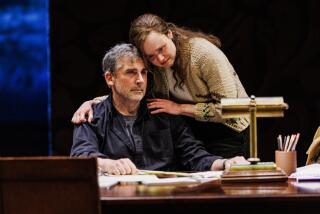‘Vita and Virginia,’ a swooning and subversive portrait of a literary love affair
- Share via
Writer-director Chanya Button crafts a swooning and surreal, subjective and subversive portrait of the affair between writers Virginia Woolf and Vita Sackville-West in her sophomore feature “Vita & Virginia.” Button adapted Eileen Atkins’ play for the screen, which itself was adapted from the letters between Woolf and Sackville-West during the height of their romantic relationship. Button’s film asserts it was as passionately intellectual as it was sensual, as creatively inspiring as it was, at times, emotionally debilitating.
Gemma Arterton stars as the rebellious aristocrat Vita Sackville-West, wife of diplomat Harold Nicolson (Rupert Penry-Jones), and much-gossiped-about seducer of women in 1920s London. Entranced by the genius of author Virginia Woolf (Elizabeth Debicki), Vita sets out to infiltrate her bohemian group of artists and writers. Meeting at a debauched costume party, the solemn, brilliant but troubled Virginia is no match for the entreaties of the impudent, imprudent and adorable Vita.
Vita and Virginia begin a correspondence, a working relationship, a friendship and, finally, a romance in full view of their husbands and friends. Their marriages aren’t so much of convenience but of “understanding,” especially for Vita and Harold, whose marriage allows them both to function in the upper-class world of society and politics while also pursuing their various affairs.
Woven around the words of the women, Button crafts a film that expresses their inner worlds cinematically. Expressive cinematography captures the tactility of the written word in its many different forms: Vita’s missives rat-a-tatting from her typewriter, Virginia’s flowing from her pen and ink the same way she writes her novels. Button shoots each woman reciting their letters in dreamy close-ups directly to the camera to create an intimacy that reaches beyond the page. Yet there’s a reverence for the technologies that enable their words to reach a wider audience, via radio, or carefully hand-set, letter by letter, in a printing press.
While some computer-generated hallucinations attributed to Woolf’s mental illness don’t always seem necessary, the film’s visual language is rich and revealing. The carefully crafted compositions by cinematographer Carlos De Carvalho, working in conjunction with the production design by Noam Piper and sumptuous costume design by Lorna Marie Mugan, visually underline the emotional states and cultural context of each woman. Vita’s daring clothing, fashionable pants, kimonos and exotic headpieces communicate as much about her personality and station in life as her own demeanor and dialogue. In one striking scene, a bereft Virginia runs through a dusty hall of big-game trophies, a room full of dead things an apt setting for this woman fixated on her own death. The electronic score by Isobel Waller-Bridge brings an anachronistic and bold sense of edge and modernity to the period piece, but it never feels out of place or jarring.
As the cerebral writer who finally finds bodily pleasure with the fiery, unpredictable Vita, Debicki demonstrates a grounded nuance and brings new elements to her range. Arterton’s performance is more arch and over the top, but one gets the sense that perhaps she’s just Virginia’s subjective perspective of Vita, so different from her, and a muse and inspiration for her genre-blending work “Orlando: A Biography.” Taking the film from Virginia’s point of view helps elide its uneven moments and lack of character depth (but not its sometimes sludgy pace). This peek into a famous love story makes the audience a participant in the affair, inspiring questions of perspective and truth in love and art, where the only truth worth anything is one deeply felt.
Katie Walsh is a Tribune News Service film critic.
‘Vita & Virginia'
Not rated
Running time: 1 hour, 50 minutes
Playing: Starts Aug. 30, Landmark Nuart, West Los Angeles; also on VOD
More to Read
Only good movies
Get the Indie Focus newsletter, Mark Olsen's weekly guide to the world of cinema.
You may occasionally receive promotional content from the Los Angeles Times.








